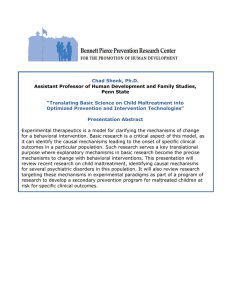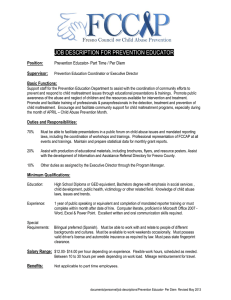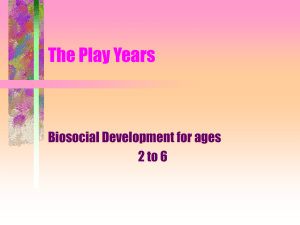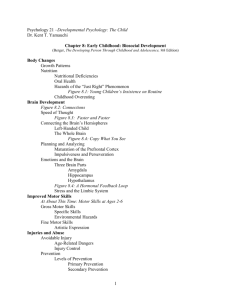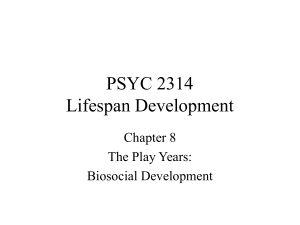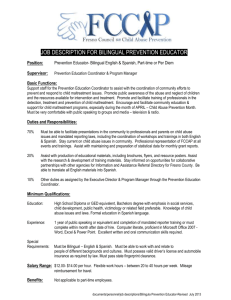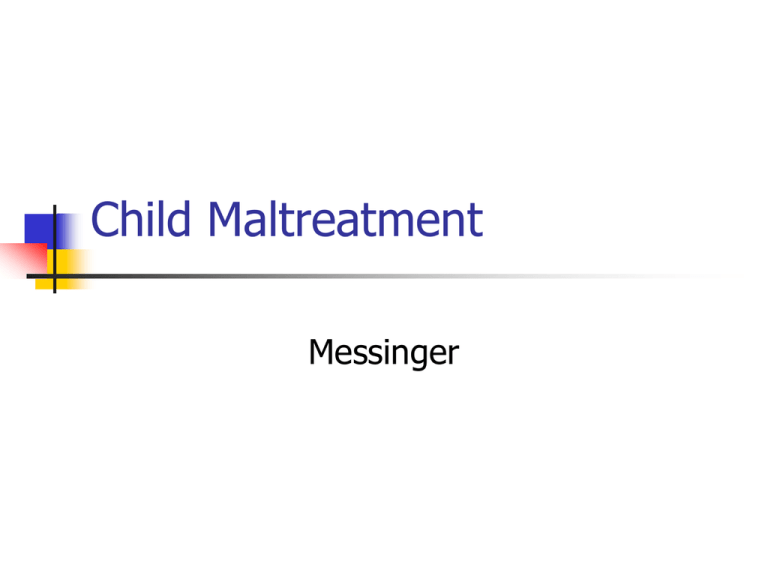
Child Maltreatment
Messinger
Questions
Define the four types of maltreatment?
What are features of families in which maltreatment occurs?
What are consequences of maltreatment on emotion
recognition?
What pathway identify to social consequences of maltreatment?
How might a child be “buffered” from adverse effects?
Do you believe prenatal substance exposure is child abuse?
What are effects of common substances and which would and would
not constitute abuse?
Acosta
Timeline of child maltreatment
Harsh discipline viewed as parent’s right
and responsibility
Idea of child maltreatment is gaining
worldwide recognition
About 3 million reports made annually
to child protective services
Acosta
Spanking?
SpankingExternalizing
Maguire-Jack, K., A. N. Gromoske, et al. (2012)..
Definition
Child maltreatment refers to four acts
Physical abuse
Emotional abuse
Sexual abuse
Neglect
Acosta
Physical abuse
World Health Organization (WHO)
Acts that result in actual or potential
physical harm, resulting from an
interaction that is within the control of a
parent or person in a position of
responsibility, power or trust
UNICEF: persons under 18 years of age who
suffer occasional or habitual acts of violence
Acosta
Emotional abuse
Failure to provide a developmentally
appropriate, supportive environment, so
that a child can establish a stable and
full range of emotional and social
competencies “commensurate with his
or her personal potential”
Acosta
Sexual abuse
Involvement of a child in sexual activity
that he/she does not fully comprehend,
is not able to give consent to, and that
violates the laws or taboos of society
Acosta
Neglect
Failure to provide for a child in all
domains: physical and mental health,
education, nutrition, shelter, and safe
living conditions, when the resources
are reasonably available to the family or
caretakers
Acosta
Incidence
National Incidence Study of Child Abuse and
Neglect (Sedlak & Broadhurst, 1995)
Overall rate of child maltreatment of over
1,500,000
Includes 750,000 cases of child abuse and 880,000 cases
of neglect
Does not discriminate across gender,
language, religion, age, ethnicity,
disability, or sexual orientation
Acosta
Results of Maltreatment
Direct effects not yet fully understood,
although it is a significant risk factor for
psychopathology
Affects all aspects of development
Acosta
Family environment
Patterns seen across maltreatment types
Family environment of coercion and abuse of
power
Lower levels of prosocial behavior and verbal
communication
Undervaluing of children
Deviant affective displays
Maternal intrusiveness and non-responsiveness
Acosta
Cognitive adaptations
Maltreated children create defensive structure
in reaction to trauma
Cognitive distortions, dissociation, vigilance
Hypervigilance: constant scanning of
environment and development of ability to
detect subtle variations in it
Dissociation: alter level of self-awareness in
an effort to escape an upsetting event or
feeling
Psychological escape
Acosta
Social and emotional adjustments
Maltreated children often suffer from
low self-esteem, self-blame, and
negative affect toward the self
Greater risk for peer rejection
The longer maltreatment occurs, the
greater the likelihood of rejection, perhaps
because of tendency to engage in coercive,
aggressive interactions with peers as result
of abuse
Emotion regulation
Involves ability to modify, redirect, and
control emotions
Maltreated children engage in efforts to
avoid, control or suppress emotion
Modulation difficulties: extreme
depressive reactions and intense angry
outbursts
Internalizing behavior problems
Anger recognition & physical
abuse
Physically abused children displayed a
response bias for angry facial
expressions.
8-11-year-old abused children
demonstrated increased attentional
benefits on valid angry trials
demonstrated delayed disengagement when
angry faces served as invalid cues.
Pollak & Tolley-Schell. Journal of Abnormal
Psychology. 112(3), Aug 2003, 323-338.
Abused see more anger
Messinger
At expense of sadness
Recognizing emotion in faces
Controls viewed discrete emotions discretely
Neglected children saw fewer distinctions
Neglected children had more difficulty
discriminating emotional expressions than
control or physically abused children.
Physically abused children showed the most
variance across emotions.
Pollak, Cicchetti, Hornung, Reed, Developmental
Psychology. 36(5), Sep 2000, 679-688.
Neglected children don’t distinguish
emotion expression pairs
Mean similarity ratings by emotion pair for control (C; solid line), neglected (N; dotted
line) and physically abused (PA; dashed line) children. A = angry, N = neutral, S = sad, F
= fearful, D = disgusted, H = happy
Heart rate change scores (bpm)
Active anger: Large
initial deceleration for both
abused and non-abused
children
Reflects attentional orienting
response
Unresolved anger:
Eventual recovery from
initial deceleration
Resolution: Greater
recovery for non-abused
than abused children
Pollak, Vardi, Bechner, & Curtin
(2005). Physically Abused
Skin conductance level change
scores
Active anger: Non-abused children had emotional
arousal response during second half
Unresolved anger: Abused children had increased midway
Abused children had relatively steady decline in SCL
Non-abused children steadily declined
Resolution: No significant main effects or interactions
Impact on emotion recognition
Influence of early adverse experience
on children's selective attention to
threat-related signals is a mechanism in
the development of psychopathology.
As children's experience varies, so will
their interpretation of emotion
expressions.
Pollak & Tolley-Schell. Journal of Abnormal
Psychology. 112(3), Aug 2003, 323-338.
Overlap with risky behaviors
Increased likelihood to engage in a greater
array of risky behaviors
Certain types of maltreatment associated with
a greater number of sexual partners and
heavier alcohol consumption
Adult survivors likely to engage in substance
abuse, criminal and antisocial behavior, and
eating disorders
Chronically maltreated kids
likely to be rejected by peers
Maltreatment chronicity higher levels of
children's aggressive behavior
reported by peers, teachers, and children
Aggressive behavior accounted for
association of maltreatment and rejection.
Socially withdrawn behavior associated with peer
rejection
but did not account for the association between chronic
maltreatment and peer rejection.
Results hold for both girls and boys
Bolger & Patterson, 2001
Maltreatment chronicity
peer rejection
Maltreatment Aggression
Maltreatment, aggression, &
rejection
Specificity of abuse effects
Sexual abuse predicted low self-esteem
Emotional maltreatment was related to
difficulties in peer relationships
but not peer relationship problems.
but not to low self-esteem.
For some groups of maltreated children,
having a good friend was associated with
improvement over time in self-esteem.
Bolger et al., 1998
Does abuse predict malfunction?
Many children and adolescents who suffer
maltreatment become well-functioning adults
Maltreatment can result in significant
negative consequences that continue into
adulthood
Although many survivors function well in
adulthood, others suffer serious psychological
distress and disturbance
Why?
Maltreating parents may fail to produce
opportunities for positive social
interaction for their children
Children who experienced a lack of
parental supervision were less likely to
be accepted by peers
Tendency to engage in unskilled or
aggressive behavior
Possible buffers
Maltreating parents may fail to produce
opportunities for positive social
interaction for their children
Opportunities found elsewhere (i.e., other
family members, friends, teachers, etc.)
Maltreated children with best friends
are more likely to experience increased
self-esteem and self-concept than other
maltreated children
‘Large’ violence & ubiquitous
violence
• How violence has been examined:
– Child maltreatment
– Aggression between parents
– Community violence
• Often looked at separately even though they co-occur
• Bias toward large injurious events rather than smaller,
more subtle violence.
• Some definitional issues
– Important to distinguish between levels of severity and
acute vs. chronic
• Almost all children experience violence (90% in Martinez's 1993
sample) Margolin & Gordis (2004)
• Margolin & Gordis
(2004)
Mattson
Short Term vs. Long Term Effects
• Short Term
– Externalizing
• Blanket but often specific to exposure (e.g., acting out of witnessed
aggression, sexual acting out)
• Social Learning (exposure to violence leads to aggressive behavior)
– Internalizing
• Emotion and mood (e.g., the world is unsafe, helplessness)
• Somatization (e.g., exaggerated startle, sleep disturbances, academic
problems)
• Long Term
– Ehrensaft et al. (2003) violence during childhood related to
increased violence by and to a partner. BUT
• Kaufman and Zigler (1987) 70% of children do not become violent
adults
• Widom (1998) "cycle of violence is not deterministic or inevitable”
Mattson
Biology
• Dysregulation of the HPA axis (stress
response)
• Cortisol levels in non-stressful
situations
• BUT variable…
– different responses in individuals
– different dysregulation of HPA axis…
– Leads to different behavioral problems
• Growth hormone, early puberty onset
• Sympathetic nervous system overactivation
– Suppressed immune function, memory
functioning
Mattson
Response and Exposure
• So why do some respond poorly?
– We have to link episodes of violence across
development to specific deficits in the
individual
– Study variation in context and delays of
presentation, vulnerable time periods
– Tertiary later effects for interpersonal
relationships
• Multiple exposure
– May just be the effect of relationship to
frequency and severity
• or a compounding of effects
• or a primary family system impact lowering the
threshold for other aggression
Mattson
Is maternal prenatal substance
exposure child abuse?
What substances would and
would not constitute abuse?
Cocaine summary
Cocaine exposed neonates are born slightly
earlier & smaller than non-exposed infants.
Slight, scattered decrements in self-regulation
at 1 month but not detectable in infant
feeding behavior
Although cocaine caregivers less involved at 1
& 4 months, no differences in secure
attachment or quality of play at 18 months
Standardized measures of development?
In general
Standardized tests of cognitive achievement,
motor performance, and language
development often show no significant
exposure effects
Effects, when present, tend to be of small
magnitude
Although Singer recently found cocaine deficits in
mental performance (and motor performance),
Frank did not.
There may be “sleeper” effects only apparent as
kids enter school
Alcohol impairs prenatal
development of brain structures
Extensive alcohol use during pregnancy altered
facial characteristics, reduced growth, and severe
cognitive deficits (Fetal Alcohol Syndrome).
Alcohol effects are dose-dependent
quantity of alcohol consumed affects severity of child deficits
Less obvious effects of alcohol exposure include reductions
in general intelligence, verbal learning, social competence.
Attention problems, memory deficits, and motor skills
problems have been associated with habitual social drinking
by the expectant mother throughout the pregnancy.
Is alcohol use child
maltreatment?
Prenatal exposure to alcohol affects one
in four births
one in twelve mothers reporting binge
drinking during the pregnancy
Individual Differences
It has been observed that although
children have undergone similar high
levels of prenatal alcohol exposure,
some will manifest severe FAS
symptomatology, some will manifest
mild effects, and some children will
appear unaffected (Able & Sokol, 1986;
Phelps & Grabowski, 1992).
Genetic factors?
One in five women reports using
tobacco while pregnant
Prenatal exposure to cigarettes
associated with premature birth, low
birth weight, and irritability in the
newborn.
Tobacco exposure is associated with
lower intelligence scores and higher risk
for attention deficit disorder in school
age children.
Current issues
Improved identification of occurrence of
maltreatment
Examination of its consequences
What determines effect of abuse?
Establishing adequate services and
supports for families and children to
protect from exploitation and harm
How to make a report
1 - 800 - 96ABUSE (1-800-9622873)
Provide the following
Victim name, address or location, approximate
age, race and sex
Signs or indications of harm or injury, including a
physical description if possible
Relationship of the alleged possible responsible
person to the victim. If the relationship is
unknown, a report will still be taken if other
reporting criteria are met.

